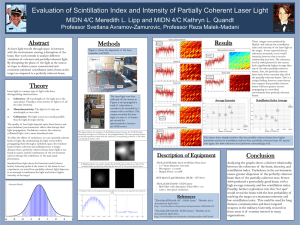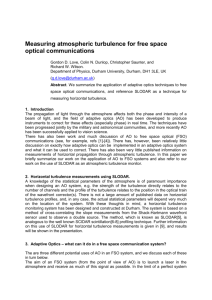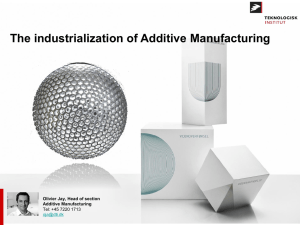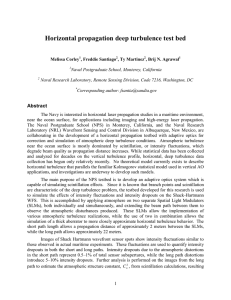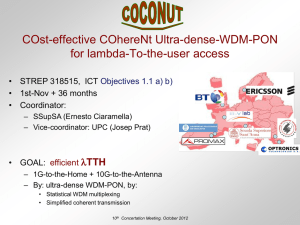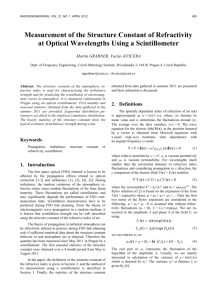Poster
advertisement
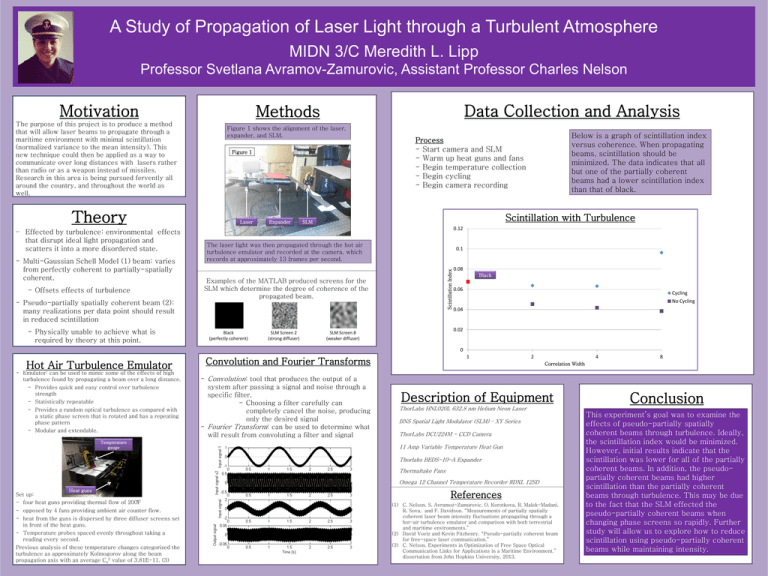
A Study of Propagation of Laser Light through a Turbulent Atmosphere MIDN 3/C Meredith L. Lipp Professor Svetlana Avramov-Zamurovic, Assistant Professor Charles Nelson Motivation Theory – Effected by turbulence: environmental effects that disrupt ideal light propagation and scatters it into a more disordered state. - Multi-Gaussian Schell Model (1) beam: varies from perfectly coherent to partially-spatially coherent. - Offsets effects of turbulence - Pseudo-partially spatially coherent beam (2): many realizations per data point should result in reduced scintillation - Physically unable to achieve what is required by theory at this point. Figure 1 shows the alignment of the laser, expander, and SLM. Figure 1 Laser Expander Below is a graph of scintillation index versus coherence. When propagating beams, scintillation should be minimized. The data indicates that all but one of the partially coherent beams had a lower scintillation index than that of black. Process - Start camera and SLM - Warm up heat guns and fans - Begin temperature collection - Begin cycling - Begin camera recording Scintillation with Turbulence SLM 0.12 The laser light was then propagated through the hot air turbulence emulator and recorded at the camera, which records at approximately 13 frames per second. 0.1 Scintillation Index The purpose of this project is to produce a method that will allow laser beams to propagate through a maritime environment with minimal scintillation (normalized variance to the mean intensity). This new technique could then be applied as a way to communicate over long distances with lasers rather than radio or as a weapon instead of missiles. Research in this area is being pursued fervently all around the country, and throughout the world as well. Data Collection and Analysis Methods Examples of the MATLAB produced screens for the SLM which determine the degree of coherence of the propagated beam. Black (perfectly coherent) SLM Screen 2 (strong diffuser) 0.08 Black 0.06 Cycling No Cycling 0.04 0.02 SLM Screen 8 (weaker diffuser) 0 Hot Air Turbulence Emulator - Emulator: can be used to mimic some of the effects of high turbulence found by propagating a beam over a long distance. - Provides quick and easy control over turbulence strength - Statistically repeatable - Provides a random optical turbulence as compared with a static phase screen that is rotated and has a repeating phase pattern - Modular and extendable. Temperature gauge 1 Convolution and Fourier Transforms - Convolution: tool that produces the output of a system after passing a signal and noise through a specific filter. - Choosing a filter carefully can completely cancel the noise, producing only the desired signal - Fourier Transform: can be used to determine what will result from convoluting a filter and signal 2 4 Correlation Width Description of Equipment ThorLabs HNL020L 632.8 nm Helium Neon Laser BNS Spatial Light Modulator (SLM) – XY Series ThorLabs DCU224M - CCD Camera 11 Amp Variable Temperature Heat Gun Thorlabs BEDS-10-A Expander Thermaltake Fans Omega 12 Channel Temperature Recorder RDXL 12SD Heat guns Set up: - four heat guns providing thermal flow of 200̊F - opposed by 4 fans providing ambient air counter flow. - heat from the guns is dispersed by three diffuser screens set in front of the heat guns. - Temperature probes spaced evenly throughout taking a reading every second. Previous analysis of these temperature changes categorized the turbulence as approximately Kolmogorov along the beam propagation axis with an average Cn2 value of 3.81E-11. (3) 8 References (1) C. Nelson, S. Avramoz-Zamurovic, O. Korotkova, R. Malek-Madani, R. Sova, and F. Davidson. “Measurements of partially spatially coherent laser beam intensity fluctuations propagating through a hot-air turbulence emulator and comparison with both terrestrial and maritime environments.” (2) David Voelz and Kevin Fitzhenry. “Pseudo-partially coherent beam for free-space laser communication.” (3) C. Nelson. Experiments in Optimization of Free Space Optical Communication Links for Applications in a Maritime Environment,” dissertation from John Hopkins University, 2013. Conclusion This experiment’s goal was to examine the effects of pseudo-partially spatially coherent beams through turbulence. Ideally, the scintillation index would be minimized. However, initial results indicate that the scintillation was lower for all of the partially coherent beams. In addition, the pseudopartially coherent beams had higher scintillation than the partially coherent beams through turbulence. This may be due to the fact that the SLM effected the pseudo-partially coherent beams when changing phase screens so rapidly. Further study will allow us to explore how to reduce scintillation using pseudo-partially coherent beams while maintaining intensity.
